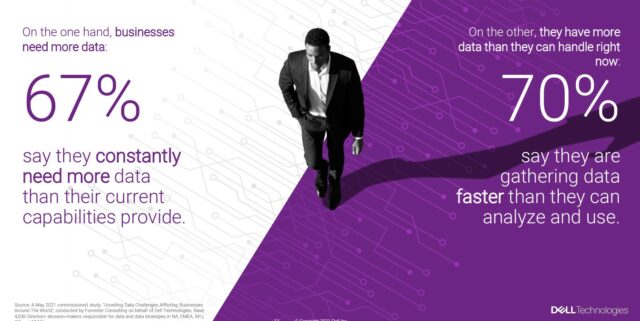By Nicholas Brackney, thought leadership, Dell Technologies
Too many people in the IT industry rely on the antiquated philosophy that suggests data is the “new oil”. But this cliché fails to capture the full value of data. Data gets compared to oil because it’s difficult to excavate and it becomes more valuable once its refined. However, there’s a big difference between the two resources: while oil is finite, our ability to produce data is inexhaustible. The more data is applied, the more value it creates, while oil once applied to one use case is spent.
Think of sales pipeline data. If all groups in an organization use the same data, it can enrich and inform upon each other’s insights and develop more value. While sales leaders can track progress against targets, finance can make forecasts and adjust spend, and marketing can gauge the effectiveness of a recent campaign, for instance.
A missed opportunity

Finding novel ways to use data sounds great in theory, yet too many organizations are failing in practice. Rather than making it easy for professionals to refine and use data, enterprise data strategies stop at the consolidation stage and employees get lost in a sea of information.
Trying to consolidate ever-expanding information resources into a single data lake is too simplistic. As many as three-quarters of businesses have experienced an increase in the demand for data, but 70% are gathering data faster than they can analyze and use it, says Dell Technologies’ research on The Data Paradox.
There’s constant tension in the technology industry between data consolidation and expansion. Organizational needs are so diverse that most enterprises are going to store data in a variety of clouds. Trying to consolidate this multicloud data will be a fool’s errand. To help businesses utilize their data resources, digital leaders must adopt a new strategy. These five steps can help organizations get to grips with the disparate data they hold.
- Recognize that everything runs on data
The plethora of devices, services and apps across organizations create and use huge amounts of data. To unlock the value of data, businesses must develop a much stronger awareness of how they will use information to create insight or drive activity. That process starts with data collection.
In many cases, a business won’t have a clear idea of what it’s going to do with all the data it collects. Professionals might be tempted to erase data that isn’t useful right now. However, it makes sense to retain as much data as you can because you can never be sure when the business will demand fresh insights on new questions or find new applications for that digital asset.
- Collect, curate, store and protect
The transportation of data is a complicated task in the digital era. Business professionals will look to move data regularly as they work. However, information resides in a multitude of data centers, cloud services and edge locations – and moving data can be a complicated and expensive task.
Digital leaders must lay the groundwork to ensure data is accessible in the future. They should think carefully about how to store data. They should focus on tagging data and should concentrate on storage management and protection. That way, digital leaders can be sure data is collected, backed up and accessed by the right people.
- Put data to work
With the right foundation in place, business leaders can focus on use cases. One example is digitizing workflows, which allows people to have access to the right data at the right time and puts it in context of their job. Think of a doctor making a diagnosis. The doctor needs easy access to various data sets related to a patient’s case, such as X-rays and blood tests. Before digital medical records and connected hospitals it could take hours to assemble all the data to make a diagnosis, now that can all be accelerated by having better access to the data.
Another use case is collaboration, which means giving multiple people the opportunity to access and work on a file at the same time. Then there’s applications and business analytics, where organizations can use data to create insight that power smarter decision-making processes.
A final high-profile use case is machine learning and AI, where these technologies can deliver new insights and automate activities. Across all these use cases, businesses should draw on the same data sets in multiple ways, enriching this information as new value is created.
- Make it effortless
Companies should introduce automation to make it easy for staff to use data held in distinct locations. Organizations that reduce the need for manual intervention create a refined end-user experience that deals with key concerns, such as data policies, security, and accessibility.
Automation can enforce policies that ensure data is automatically stored in the right place, whether that’s the public cloud, on-premises data centers, or a hybrid location. Automation can also support tiering, so data that hasn’t been used for a certain period is automatically pushed to an archive.
- Stay open to get ahead
Open and API-driven organizations allow their users to hook into data across all environments. The enterprise data strategy should make it easy to call on local resources and share data widely. For this openness to become manifest, businesses should provide a user interface that simplifies data management across multiple storage environments.
Achieving effective orchestration, however, isn’t straightforward. Businesses should take a software-defined approach to ensure the solutions they use work effectively across all the locations where data resides. Organizations should also select a secure, reliable, and high-performing architecture that allows people to use whatever platforms they choose across all use cases and workloads.
Towards a new data strategy
Technology requirements can change quickly. Executives dealing with data must be pragmatic. Organizations and their employees will continue to use a range of platforms. Rather than assuming data is consolidated and constrained, businesses need to create an open data strategy that supports a broad range of environments. Only then will data be fully utilized as the valuable resource it can and should be.

